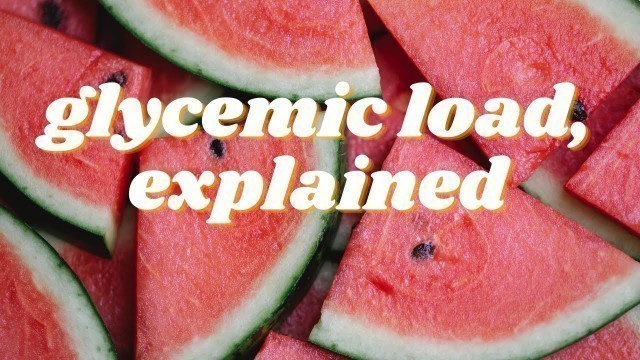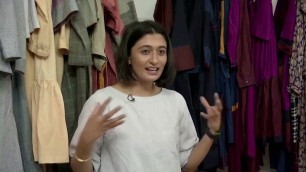

'What is the glycemic load, and why does it matter more than the glycemic index? Subscribe to Nourishable at https://www.youtube.com/c/Nourishable Glycemic Responses Series - stay tuned each week! https://youtube.com/playlist?list=PLK6oS2Cd-6PFz0Xjkti_6iAselQclvl0z Follow Nourishable on twitter, facebook and instagram to stay up to date on all things nutrition. https://twitter.com/nourishable fb.me/nourishable.tv https://www.instagram.com/nourishable/ Hosting, Research, Writing & Post-Production by Lara Hyde, PhD http://www.nourishable.tv Music & Video Production by Robbie Hyde https://www.youtube.com/user/chedderchowder Opening Motion Graphics by Jay Purugganan https://www.c9studio.com/WP/ Script with in-text citations: https://bit.ly/3l68hDu The information in this video is not intended or implied to be a substitute for professional medical advice, diagnosis or treatment. All content, including text, graphics, images and information, contained on or available through this video is for general information purposes only. References https://pubmed.ncbi.nlm.nih.gov/26160327/ https://www.ncbi.nlm.nih.gov/pmc/articles/PMC6628270/ https://www.mayoclinic.org/healthy-lifestyle/nutrition-and-healthy-eating/in-depth/glycemic-index-diet/art-20048478 https://pubmed.ncbi.nlm.nih.gov/12081850/ https://pubmed.ncbi.nlm.nih.gov/19079901/ https://fdc.nal.usda.gov/fdc-app.html#/food-details/1102698/nutrients https://care.diabetesjournals.org/content/31/12/2281 https://glycemicindex.com/ https://www.diabetes.co.uk/diet/glycemic-load.html Additional Footage Pexels Any Lane, Karolina Grabowska Freepik macrovector You may be familiar with the glycemic index, or GI, because it’s frequently recommended to eat low GI foods for health. The glycemic index is a method used to categorize foods based on how they impact your blood glucose. The way this works is the blood glucose response to a test food, say this whole wheat bread, is measured over two hours, and its compared to the blood glucose response for a reference food, like a sugar drink. Based on these comparisons, foods can be categorized as low GI, meaning that they don’t raise your blood glucose much, medium GI, or high GI, meaning that they raise your blood glucose alot. So it follows that if you want to avoid high spikes in blood glucose that you should avoid high GI foods, right? Well, it’s a bit more complicated than that, because here’s the thing - the method for determining the glycemic index requires eating 50 grams of digestible carbohydrate - so that’s 50 grams of sucrose in the sugar drink, or 50 grams of carbs minus the fiber in the whole wheat bread. And depending on the test food, sometimes 50 grams of carbs is a WAY bigger serving size than you’d ever reasonably eat in a sitting. When I did my GI experiment with Dave’s Killer Seed Bread (not an ad, just a fan), I had to eat three full slices to get 50 grams of digestible carbs. This conundrum is even more striking with watermelon. I’d need to eat 4.5 cups of watermelon to get 50 grams of digestible carbs - that’s nearly an entire watermelon! Previous studies have calculated the glycemic index of watermelon to be 76, which categorizes it as a high GI food. But if we want a tool to help predict glycemic responses in the real world, we need to take the typical serving sizes into consideration. That’s where glycemic load comes in. The glycemic load, or GL, is a ranking system that corrects the glycemic index for the number of carbohydrates in typical serving size. To calculate the GL, you multiply the number of digestible carbs in a serving by the GI and divide by 100. We know that watermelon has a high GI of 76, but it’s mostly water! A typical 100g serving of watermelon has 7g of digestible carbs. To calculate the GL we take that 7 gram serving of carbs multiplied by the GI of 76 and divide by 100 to give us a GL of 5. Foods are categorized into low, medium, or high GL. where a lower GL means a serving of food raises your blood glucose less. This categorizes watermelon as a low glycemic load food - so a typical serving size won’t cause a huge spike in blood glucose. Overall, the glycemic load is a better reflection of expected blood glucose responses to foods based on how much we usually eat in one sitting. That makes it more useful than the glycemic index. There are still some more complications with the applicability of the glycemic load in the real world, and I dig into them in my glycemic responses video series.'
Tags: watermelon , blood glucose , glycemic index , nourishable , Lara Hyde , Dr Lara , glycemic load , GL foods , postprandial glycemic responses , blood glucose spikes , nourishable youtube
See also:













!['Fashion Dress Women Fashion [2018 Best Sellers]: Black Lace Shrug Bolero, Cropped Jacket Short'](https://cdn-img01.abouthomedesignvideo.com/images/31-m/145/1453350_m.jpg)



comments